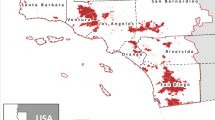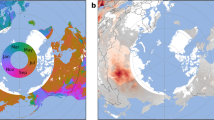Abstract
Wildfire can impose a direct impact on human health under climate change. While the potential impacts of climate change on wildfires and resulting air pollution have been studied, it is not known who will be most affected by the growing threat of wildfires. Identifying communities that will be most affected will inform development of fire management strategies and disaster preparedness programs. We estimate levels of fine particulate matter (PM2.5) directly attributable to wildfires in 561 western US counties during fire seasons for the present-day (2004–2009) and future (2046–2051), using a fire prediction model and GEOS-Chem, a 3-D global chemical transport model. Future estimates are obtained under a scenario of moderately increasing greenhouse gases by mid-century. We create a new term “Smoke Wave,” defined as ≥2 consecutive days with high wildfire-specific PM2.5, to describe episodes of high air pollution from wildfires. We develop an interactive map to demonstrate the counties likely to suffer from future high wildfire pollution events. For 2004–2009, on days exceeding regulatory PM2.5 standards, wildfires contributed an average of 71.3 % of total PM2.5. Under future climate change, we estimate that more than 82 million individuals will experience a 57 % and 31 % increase in the frequency and intensity, respectively, of Smoke Waves. Northern California, Western Oregon and the Great Plains are likely to suffer the highest exposure to widlfire smoke in the future. Results point to the potential health impacts of increasing wildfire activity on large numbers of people in a warming climate and the need to establish or modify US wildfire management and evacuation programs in high-risk regions. The study also adds to the growing literature arguing that extreme events in a changing climate could have significant consequences for human health.



Similar content being viewed by others
References
Ammann H, Blaisdell R, Lipsett M, Stone SL, Therriault S (2001) Wildfire smoke: a guide for public health officials
Anderson GB, Bell ML (2011) Heat waves in the United States: mortality risk during heat waves and effect modification by heat wave characteristics in 43 U.S. communities. Environ Health Perspect 119:210–218
Andreae MO, Merlet P (2001) Emission of trace gases and aerosols from biomass burning. Glob Biogeochem Cycles 15:955–966
Balshi MS, McGuirez AD, Duffy P, Flannigan M, Walsh J, Melillo J (2009) Assessing the response of area burned to changing climate in western boreal North America using a Multivariate Adaptive Regression Splines (MARS) approach. Glob Chang Biol 15:578–600
Brown TJ, Hall BL, Westerling AL (2004) The impact of twenty-first century climate change on wildland fire danger in the western United States: an applications perspective. Clim Chang 62:365–388
Delfino RJ, Zeiger RS, Seltzer JM, Street DH, McLaren CE (2002) Association of asthma symptoms with peak particulate air pollution and effect modification by anti-inflammatory medication use. Environ Health Perspect 110:A607–A617
Dennis A, Fraser M, Anderson S, Allen D (2002) Air pollutant emissions associated with forest, grassland, and agricultural burning in Texas. Atmos Environ 36:3779–3792
Dombeck MP, Williams JE, Wood CA (2004) Wildfire policy and public lands: integrating scientific understanding with social concerns across landscapes. Conserv Biol 18:883–889
Dominici F, Peng RD, Bell ML, Pham L, McDermott A, Zeger SL, Samet JM (2006) Fine particulate air pollution and hospital admission for cardiovascular and respiratory diseases. JAMA-J Am Med Assoc 295:1127–1134
Flannigan M, Stocks B, Turetsky M, Wotton M (2009) Impacts of climate change on fire activity and fire management in the circumboreal forest. Glob Chang Biol 15:549–560
Flannigan MD, Logan KA, Amiro BD, Skinner WR, Stocks BJ (2005) Future area burned in Canada. Clim Chang 72:1–16
Fried JS, Torn MS, Mills E (2004) The impact of climate change on wildfire severity: a regional forecast for northern California. Clim Chang 64:169–191
Gielen MH, vander Zee SC, van Wijnen JH, van Steen CJ, Brunekreef B (1997) Acute effects of summer air pollution on respiratory health of asthmatic children. Am J Respir Crit Care Med 155:2105–2108
Hänninen OO, Salonen RO, Koistinen K, Lanki T, Barregard L, Jantunen M (2009) Population exposure to fine particles and estimated excess mortality in Finland from an East European wildfire episode. J Expo Sci Environ Epidemiol 19:414–422
Hystad PW, Keller PC (2008) Towards a destination tourism disaster management framework: long-term lessons from a forest fire disaster. Tourism Manag 29:151–162
Interagency Working Group on Climate Change and Health (2010) A human health perspective on climate change: a report outlining the research needs on the human health effects of climate change
Intergovernmental Panel on Climate Change (IPCC) (2001) Working group I: the scientific basis
Krawchuk MA, Moritz MA, Parisien MA, Van Dorn J, Hayhoe K (2009) Global pyrogeography: the current and future distribution of wildfire. PLoS One 4
Krzyzanowski M, Cohen A (2008) Update of WHO air quality guidelines. Air Qual Atmos Hlth 1:7–13
Lighty JS, Veranth JM, Sarofim AF (2000) Combustion aerosols: factors governing their size and composition and implications to human health. J Air Waste Manag 50:1565–1618
Littell JS, McKenzie D, Peterson DL, Westerling AL (2009) Climate and wildfire area burned in western U. S. ecoprovinces, 1916–2003. Ecol Appl 19:1003–1021
Liu JC, Mickley LJ, Sulprizio MP, Yue X, Dominici F, Bell ML (2016) Exposure to wildfire-specific fine particulate matter and risk of Hospital Admissions in urban and rural Counties in the Western US 2004–2009 Epidemiology (Cambridge, Mass.) (accepted)
Liu JC, Pereira G, Uhl SA, Bravo MA, Bell ML (2015) A systematic review of the physical health impacts from non-occupational exposure to wildfire smoke. Environ Res 136:120–132
Marlon JR, Bartlein PJ, Gavin DG, Long CJ, Anderson RS, Briles CE, Brown KJ, Colombaroli D, Hallett DJ, Power MJ, Scharf EA, Walsh MK (2012) Long-term perspective on wildfires in the western USA. Proc Natl Acad Sci U S A 109:E535–E543
Meehl GA, Stocker TF (2007) Global climate projections. Climate Change 2007: The Physical Science Basis: 747–845
Moore D, Copes R, Fisk R, Joy R, Chan K, Brauer M (2006) Population health effects of air quality changes due to forest fires in British Columbia in 2003: estimates from physician-visit billing data. Canadian J Public Health = Revue canadienne de sante publique 97:105–108
Phuleria HC, Fine PM, Zhu YF, Sioutas C (2005) Air quality impacts of the October 2003 Southern California wildfires. J Geophys Res-Atmos 110
Pope CA, Ezzati M, Dockery DW (2009) Fine-particulate air pollution and life expectancy in the United States. New Engl J Med 360:376–386
Puett RC, Hart JE, Yanosky JD, Paciorek C, Schwartz J, Suh H, Speizer FE, Laden F (2009) Chronic fine and coarse particulate exposure, mortality, and coronary heart disease in the nurses’ health study. Environ Health Perspect 117:1697–1701
Querol X, Alastuey A, Ruiz CR, Artinano B, Hansson HC, Harrison RM, Buringh E, ten Brink HM, Lutz M, Bruckmann P, Straehl P, Schneider J (2004) Speciation and origin of PM10 and PM2.5 in selected European cities. Atmos Environ 38:6547–6555
Sapkota A, Symons JM, Kleissl J, Wang L, Parlange MB, Ondov J, Breysse PN, Diette GB, Eggleston PA, Buckley TJ (2005) Impact of the 2002 Canadian forest fires on particulate matter air quality in Baltimore City. Environ Sci Technol 39:24–32
Schoennagel T, Veblen TT, Romme WH (2004) The interaction of fire, fuels, and climate across rocky mountain forests. Bioscience 54:661–676
Schwartz J, Dockery DW, Neas LM (1996) Is daily mortality associated specifically with fine particles? J Air Waste Manag 46:927–939
Spracklen DV, Logan JA, Mickley LJ, Park RJ, Yevich R, Westerling AL, Jaffe DA (2007) Wildfires drive interannual variability of organic carbon aerosol in the western US in summer. Geophys Res Lett 34
Spracklen DV, Mickley LJ, Logan JA, Hudman RC, Yevich R, Flannigan MD, Westerling AL (2009) Impacts of climate change from 2000 to 2050 on wildfire activity and carbonaceous aerosol concentrations in the western United States. J Geophys Res-Atmos 114
Tai APK, Mickley LJ, Jacob DJ (2012) Impact of 2000–2050 climate change on fine particulate matter (PM2.5) air quality inferred from a multi-model analysis of meteorological modes. Atmos Chem Phys 12:11329–11337
US Census (2005) Age and sex composition in the United States: 2005. Table 1.1. Population
US Census National Population Projections (2012) 2012 National population projections: summary tables. Table 1. Projections of the population and components of change for the United States: 2015 to 2060 (Middle Series)
US Environmental Protection Agency (2011a) About ICLUS. pp. https://www.epa.gov/iclus/about-iclus
US Environmental Protection Agency (2011b) ICLUS tools and datasets (Version 1.3 & 1.3.1)
Westerling AL, Hidalgo HG, Cayan DR, Swetnam TW (2006) Warming and earlier spring increase western US forest wildfire activity. Science 313:940–943
Wonaschutz A, Hersey SP, Sorooshian A, Craven JS, Metcalf AR, Flagan RC, Seinfeld JH (2011) Impact of a large wildfire on water-soluble organic aerosol in a major urban area: the 2009 Station Fire in Los Angeles County. Atmos Chem Phys 11:8257–8270
Yue X, Mickley LJ, Logan JA (2014) Projection of wildfire activity in southern California in the mid-twenty-first century. Clim Dyn 43:1973–1991
Yue X, Mickley LJ, Logan JA, Kaplan JO (2013) Ensemble projections of wildfire activity and carbonaceous aerosol concentrations over the western United States in the mid-21st century. Atmos Environ 77:767–780
Zhang L, Jacob DJ, Yue X, Downey NV, Wood DA, Blewitt D (2014) Sources contributing to background surface ozone in the US Intermountain West. Atmos Chem Phys 14:5295–5309
Acknowledgments
We received funding support from NIH/NIEHS R21 ES022585-01 (Dominici); NIH R01 ES019560 (Peng); NIH R21 ES020152 (Peng); NIH R21 ES024012 (Zanobetti); NIH R21 ES021427 (Bell); NIH/NIEHS R01 ES024332 (Zanobetti), and the Yale Institute for Biospheric Studies.
Author information
Authors and Affiliations
Corresponding author
Ethics declarations
Conflict of interest
The authors declare that they have no conflict of interest.
Electronic supplementary material
Below is the link to the electronic supplementary material.
ESM 1
(DOCX 872 kb)
Rights and permissions
About this article
Cite this article
Liu, J.C., Mickley, L.J., Sulprizio, M.P. et al. Particulate air pollution from wildfires in the Western US under climate change. Climatic Change 138, 655–666 (2016). https://doi.org/10.1007/s10584-016-1762-6
Received:
Accepted:
Published:
Issue Date:
DOI: https://doi.org/10.1007/s10584-016-1762-6




